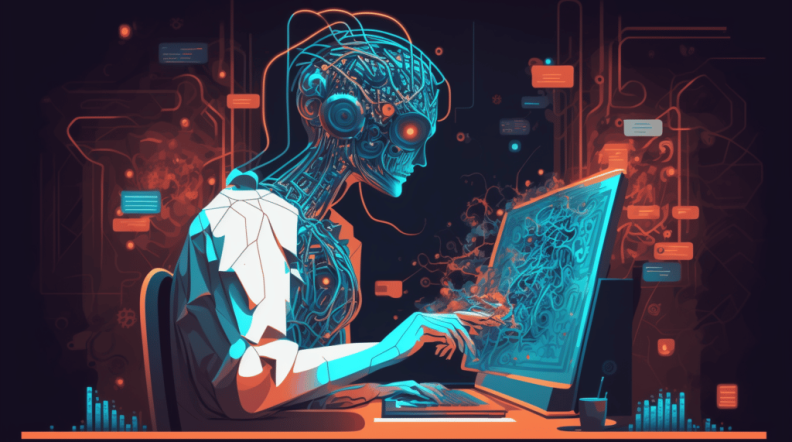Best AI Programming Language: A Comprehensive Guide for 2024






In the rapidly evolving field of computer science, AI and machine learning have become central pillars, pushing the boundaries of what’s possible with technology. Choosing the best programming language for AI projects is crucial, as it impacts everything from rapid prototyping to the scalability of AI systems. Among the myriad of options, certain languages have emerged as frontrunners, each with unique strengths and community support.
While Python remains the go-to for many AI developers, thanks to its simplicity and wide array of libraries, other languages like Java and C++ offer advantages in specific contexts, such as performance-intensive applications or enterprise-level solutions. This guide aims to navigate through these options, providing a clear overview of the top languages suitable for AI development as we move into 2024.
Introduction to the World of AI Programming
The realm of AI programming is diverse, encompassing various aspects of technology, including machine learning applications, neural networks, and data analysis. At its core, AI programming combines the principles of computer science with specialized algorithms to create systems capable of learning, adapting, and even making decisions. The choice of programming language can significantly affect the development process, influencing everything from the ease of coding to the performance of the final AI systems.
Among the plethora of languages, Python and R stand out for their extensive libraries and user-friendly syntax, making them ideal for beginners in AI and scientific computing. Java, with its platform independence, robust tools, and extensive libraries like Deeplearning4j, suits complex neural network projects and enterprise-level applications. On the other hand, languages such as C++ provide the low-level control needed for performance-intensive AI models, making them indispensable for certain types of AI projects.
AI programming also requires a deep understanding of data manipulation, symbolic reasoning, and machine learning algorithms. Libraries and frameworks designed specifically for AI, such as TensorFlow and Keras, offer ai developers powerful tools for building and deploying AI systems. The choice of language often depends on the project requirements, including the need for rapid development, scalability, and integration with existing systems.
The field of AI is continuously evolving, with new advancements and languages emerging regularly. This dynamic nature requires AI programmers to stay informed about the latest trends, tools, and best practices. As AI becomes increasingly integrated into various sectors, the demand for skilled programmers across different languages for artificial intelligence continues to grow, shaping the future of technology and innovation.
Exploring the Top AI Programming Languages
In 2024, the landscape of AI programming languages encompasses a variety of options, each with its strengths and areas of specialization. From Python’s vast ecosystem of libraries and straightforward syntax to Java’s platform independence and the high-level neural network capabilities of languages like Julia, the best AI programming languages offer a range of features catering to different aspects of AI and machine learning development. The decision on which language to use is often guided by the specific needs of AI projects, including factors such as performance requirements, development speed, and the availability of ai-specific libraries and frameworks.
1. Python: The Leading Language for AI
Python stands at the forefront of AI development, favored for its simplicity, extensive libraries, and supportive community. Its position as a general-purpose programming language, combined with a rich ecosystem of open-source libraries tailored for AI and machine learning, makes it particularly appealing for beginners in AI and experienced developers alike. Python’s flexibility in handling various types of AI projects, from deep learning models to statistical models, underscores its dominance in the field.
Why Python is Often Recommended for AI Development
Python’s reputation as the best programming language for ai stems from its simplicity and flexibility, crucial in AI where dealing with large amounts of data is common. Libraries such as TensorFlow and Keras enhance Python’s capabilities, allowing for the efficient development of sophisticated AI and machine learning applications. This ease of use, combined with the language’s vast resources for data analysis and machine learning, makes Python an ideal choice for rapid development in the AI domain.
Libraries and Frameworks in Python for AI
The rich ecosystem of Python’s libraries and frameworks is unparalleled in facilitating AI projects. From TensorFlow for creating complex neural networks to Scikit-learn for more traditional machine learning algorithms, these tools offer AI developers the resources needed to build, test, and deploy AI models efficiently. This extensive support significantly reduces development time and allows for the exploration of innovative AI solutions.
2. Java: Versatile and Robust
Java’s platform independence and robust tools make it a strong candidate for AI projects, especially those developed in enterprise environments. Its extensive libraries like Deeplearning4j and Apache Jena provide ai developers with powerful resources for building ai systems capable of complex data manipulation and natural language processing. Java’s ability to handle large data sets and integrate with existing systems further solidifies its role in the development of scalable and efficient AI applications.
How Java Benefits AI Programming
Java, being a statically typed language, offers benefits in terms of performance and reliability that are critical in AI and machine learning projects. Its platform independence ensures that AI systems developed in Java can run on any device, enhancing the applicability of Java-based AI solutions. The wide array of libraries and tools available for Java developers facilitates the development of advanced AI applications, from machine learning models to complex neural networks.
Java’s Role in Enterprise-Level AI Applications
In the sphere of enterprise-level AI applications, Java’s versatility and robustness come to the forefront. Its strong security features, scalability, and the ability to handle large amounts of data make it an optimal choice for businesses aiming to integrate AI into their operations. Java’s extensive ecosystem, including libraries like Deeplearning4j, allows for the development of sophisticated AI solutions that can drive innovation and efficiency in corporate environments.
3. C++: For Performance-Intensive AI Applications
When it comes to performance-intensive AI applications, C++ is often the go-to language for ai engineers. Its low-level control over hardware and efficient execution make it ideal for developing high-speed AI models. Although it may have a steeper learning curve, the benefits of using C++ in scenarios where execution speed and resource management are critical cannot be overstated.
The Contribution of C++ to AI Development
C++ plays a crucial role in the advancement of AI, offering a foundation for developing advanced ai systems that require high performance and efficiency. Its rich set of features and robust tools support the creation of complex AI models, including those used in gaming, real-time systems, and scientific computing. The language’s efficiency and speed are particularly beneficial in applications where response time is critical, making C++ a valuable asset in the AI developer’s toolkit.
Comparing C++ with Other AI Programming Languages
While C++ offers unmatched speed and efficiency for certain types of AI applications, it contrasts with languages like Python in terms of ease of use and development speed. Python’s extensive libraries and simpler syntax make it more accessible for rapid prototyping and development of AI models. However, for projects where performance is paramount, C++ provides the necessary control and efficiency, demonstrating its continued relevance in the field of AI programming.
4. Lisp: The AI Pioneer
Lisp, known as the logic programming language, has been crucial in AI development since its inception. Its flexibility and the ability to easily handle symbolic reasoning make it particularly suited for projects involving virtual assistants and natural language processing. Despite newer languages gaining popularity, Lisp’s historical significance and unique features continue to make it a valuable tool for specific AI development tasks.
What Makes Lisp Suitable for AI Development
The characteristics of Lisp as a logic programming language, including its flexibility and suitability for symbolic reasoning, make it uniquely capable of handling complex AI development challenges. Its syntax and structure are designed to facilitate the rapid development of AI algorithms, making it a strong contender for projects that require a high degree of complexity and adaptability.
Historical Significance of Lisp in AI
Lisp’s contribution to the AI field cannot be understated. Developed by John McCarthy, one of the founders of artificial intelligence, Lisp was the first language to be used for AI development. Its design philosophy, centered around the manipulation of symbols and lists, directly addressed the needs of early AI research, laying the groundwork for many of the concepts and techniques used in AI programming today. Despite the evolution of programming languages, Lisp’s legacy in AI development continues to influence the field.
5. R: The Statistician’s Choice for AI
R excels in AI tasks, especially due to its superior data handling capabilities, object-oriented nature, and strength in vectorial computation. These features make R a preferred tool for statisticians and data scientists looking to delve into AI-driven data analysis and modeling.
Utilizing R in AI for Data Analysis
R’s power in AI data analysis is unmatched, particularly in domains like computer vision and data mining. Its speed and efficiency in statistical modeling make it a go-to for projects ranging from self-driving cars to predictive analytics, showcasing its flexibility across various AI applications.
R vs. Python in AI Development
While Python is often the first choice for many AI developers, R holds its ground in the world of AI, especially in statistical and deep neural networks projects. The choice between R and Python usually comes down to the specific needs of the project and the developer’s familiarity with each language.
6. JavaScript: Bringing AI to the Web
JavaScript is revolutionizing the web with advanced AI capabilities, making sophisticated AI functionalities accessible in web applications, enhancing user experience and website intelligence.
The Growing Role of JavaScript in AI
JavaScript’s role in AI is expanding, with libraries and tools that integrate AI directly into the browser. This allows for real-time AI applications, such as chatbots and personalized content, directly on web platforms.
AI Development Using JavaScript Libraries
The development of AI applications has been made more accessible with JavaScript libraries. These tools provide a framework for implementing complex AI functionalities, including machine learning models, into web applications effortlessly.
7. Scala: Functional Programming for AI
Scala offers a rich ecosystem and the ability to handle complex machine learning projects efficiently, making it a popular choice among developers looking for robust functional programming options in AI.
Scala’s Unique Position in AI Development
Scala’s integration with powerful AI and machine learning libraries positions it uniquely in AI development. Its functional programming capabilities make it ideal for building scalable and high-performance AI applications.
Integration of Scala with Apache Spark
The integration of Scala with Apache Spark has made it a premier choice for big data processing and AI. This combination allows developers to process vast amounts of data efficiently, crucial for training complex machine learning models.
8. Julia: High-Performance AI Programming
Julia is rapidly becoming a favorite among AI developers due to its high-performance capabilities, extensive libraries and tools, and superior data handling, particularly in parallel and distributed computing environments.
Why Julia is Gaining Popularity in AI
Julia’s popularity in AI is on the rise, thanks to its ability to handle complex numerical analysis and its extensive libraries and tools that support parallel and distributed computing, making it ideal for high-performance AI applications.
Julia’s Strengths in Handling Complex Numerical Analysis
Julia excels in complex numerical analysis, critical for AI tasks such as computer vision and machine learning. Its speed and efficiency, combined with powerful data mining and statistical modeling capabilities, make it a top choice for developing sophisticated AI applications, including self-driving cars.
9. Prolog: Logic Programming for AI
Prolog, with its declarative nature, is favored by AI developers for creating complex algorithms, especially in AI systems that require sophisticated pattern matching and problem-solving capabilities.
The Use of Prolog in AI Applications
Prolog’s strength in logic programming makes it ideal for AI applications that require rule-based logical reasoning, such as expert systems and natural language processing, showcasing its versatility and power in the AI space.
Prolog’s Niche in Rule-Based AI Systems
Prolog has carved a niche for itself in the development of rule-based AI systems. Its ability to efficiently manage complex rule sets and its ease of use in logical reasoning tasks make it a valuable tool for developers working on advanced AI projects.
10. Haskell: Purely Functional Programming for AI
Haskell, with its purely functional programming paradigm, stands out in the AI landscape. Its rich ecosystem and ability to handle complex machine learning projects make it a compelling choice. Haskell’s lazy evaluation and support for infinite data structures allow developers to model problems in a highly expressive and efficient manner, paving the way for innovative AI solutions.
Haskell’s Role in AI Development
Haskell’s unique features contribute significantly to AI development. Its strong static type system and pure functions minimize side effects, making code easier to understand, maintain, and predict. This reliability is crucial for building robust AI systems. Moreover, Haskell’s efficiency in handling complex algorithms and data-intensive tasks makes it a valuable tool for researchers and developers working on cutting-edge AI projects.
The Advantages of Haskell’s Pure Functions in AI
The use of pure functions in Haskell offers clear advantages for AI development. These functions ensure predictability and reusability, essential for creating stable and efficient AI models. The absence of side effects allows for easier debugging and testing, significantly improving the development process. Haskell’s approach encourages a more mathematical logic to problem-solving, aligning closely with AI’s foundational principles.
Deciding on the Best Programming Language for Your AI Project
Choosing the right programming language for an AI project involves considering various factors. Python and Java are often recommended for their extensive libraries in computer vision and data mining. For projects requiring high performance, like real-time systems, languages such as C++ may be preferable. Ultimately, the best programming languages for AI development are those that align with the project’s specific needs and goals.
Assessing Your Project’s Needs and Goals
Understanding the specific needs and goals of your AI project is crucial. Whether it’s developing an application with sophisticated numerical computation capabilities or leveraging AI for computer vision, identifying these requirements will guide the selection of the most suitable programming language. Consider the project’s scale, complexity, and the desired outcome to make an informed decision.
Skill Level and Learning Curve Considerations
The choice of programming language for AI also depends on the skill level and the learning curve. Beginners might find Python more accessible due to its straightforward syntax and extensive documentation. However, for developers with a strong background in functional programming, languages like Haskell could offer a stimulating challenge. Balancing the team’s expertise with the project’s demands is key.
Evaluating Community Support and Libraries Availability
Community support and the availability of libraries are pivotal in AI development. Languages with a vibrant community of AI developers, like Python, offer extensive resources, including neural network libraries and tutorials, which can accelerate development. A rich ecosystem not only provides pre-built functions but also ensures that help is readily available, making problem-solving faster and more efficient.
Performance, Stability, and Future-Proofing
Performance, stability, and future-proofing are essential factors in selecting a programming language for AI. Languages that offer high performance and stability, such as C++ for machine learning projects, are preferred for their efficiency. Additionally, choosing a language that is continuously updated and widely used in the AI community can safeguard your project from becoming obsolete.
Navigating the AI Programming Landscape
The AI programming landscape is diverse, with each language offering unique benefits for different types of projects. Understanding these nuances is crucial for developers. A comparative analysis of languages based on factors like performance, ease of use, and community support can help navigate this complex field, ensuring the choice of the most appropriate language for your AI initiative.
Comparative Analysis of AI Programming Languages
A comparative analysis of AI programming languages reveals distinct advantages in areas such as computer vision and data analysis. Python, for instance, is renowned for its simplicity and rich libraries, making it ideal for beginners and complex projects alike. C++ offers unmatched performance for real-time applications, while Haskell excels in dealing with abstract and complex algorithms efficiently.
The Evolution of AI Programming Languages Over Time
The evolution of AI programming languages over time reflects the changing needs and complexities of AI development. From Lisp, the pioneering language of AI, to Python, which has become synonymous with modern AI applications, this progression underscores the industry’s adaptation to more sophisticated and varied AI challenges. Each generation of languages has contributed new concepts and tools, enriching the AI development landscape.
Integration and Compatibility Across Different Platforms
Integration and compatibility across different platforms are critical in today’s interconnected technology landscape. Languages that offer cross-platform support and seamless integration with various tools and frameworks are increasingly preferred. This flexibility enables developers to build more versatile and robust AI solutions that can operate across different environments without significant modifications.
Setting the Foundation for AI Development
Setting a solid foundation for AI development begins with choosing the right programming language. This choice impacts not only the development process but also the performance and scalability of the AI solution. Beginners should focus on languages that are not only powerful but also have a gentle learning curve and a supportive community, setting the stage for successful and innovative AI projects.
Where to Begin with AI Programming
For those new to AI, beginning with a language that has a strong support system and resources is crucial. Python, with its simplicity and vast array of libraries, offers a welcoming entry point for newcomers. Starting with small projects and gradually increasing complexity can help build confidence and proficiency in AI programming, laying the groundwork for more advanced work.
Building Intelligent Applications: A Starter’s Guide
Building intelligent applications requires a foundational understanding of AI principles and the right tools. A starter’s guide should focus on mastering the basics of a versatile language like Python or Java, both known for their efficacy in AI development. Engaging in projects that offer practical experience, such as those involving computer vision or numerical computation, can provide invaluable insights into the rapidly growing field of AI.
Tips for Future-Proofing Your AI Skills and Knowledge
To ensure longevity in the rapidly evolving field of AI, continuously learning and adapting is key. Focusing on foundational concepts such as algorithms, data structures, and statistical computations will provide a solid base. Embracing interdisciplinary learning, including areas like cognitive science and ethics, can also enrich one’s understanding and application of AI. Participating in projects involving diverse applications from game development to healthcare can broaden experience and expertise. Staying updated with the latest research, tools, and technologies through journals, conferences, and online communities will keep skills relevant and cutting-edge.
The Future Awaits: How These Languages Shape Tomorrow’s AI
The landscape of AI programming languages is pivotal in shaping the future of technology. Python’s simplicity and rich library ecosystem make it an ideal candidate for leading the charge in AI innovation, fostering advancements in machine learning and deep learning. Java’s robustness and versatility ensure its continued use in large-scale, enterprise-level AI applications, where reliability and performance are critical. Meanwhile, languages like Julia, with their high-performance capabilities in complex numerical analysis, are breaking new ground in scientific computing and AI research.
Emerging languages such as Scala and Haskell offer unique paradigms like functional programming, which can lead to more efficient, error-free code in AI systems. The evolution of AI also sees languages like JavaScript extending AI applications into web environments, making AI more accessible to a broader audience. As AI technologies become more pervasive, the role of programming languages in facilitating seamless integration and compatibility across different platforms becomes increasingly significant.
The future of AI will likely witness a convergence of languages, each bringing their strengths to address specific challenges. For instance, Prolog’s prowess in rule-based AI systems and Lisp’s historical significance and suitability for AI development highlight the diversity of tools available to developers. This variety ensures that regardless of the AI challenge at hand, there is a programming language well-suited to address it.
Moreover, as AI development pushes the boundaries of what’s possible, the need for languages that can efficiently manage memory allocation and handle statistical computations will rise. The adaptability of these programming languages to meet the future needs of AI will play a crucial role in the advancement of AI technologies. Their evolution will directly impact how AI shapes our world, from healthcare and education to environmental protection and beyond.
Mastering AI Programming: Your Pathway to Building the Future
Embarking on a journey to master AI programming requires a commitment to continuous learning and exploration. Beginners should start with languages like Python, known for its ease of use and comprehensive libraries for AI and machine learning. As one progresses, diving deeper into languages that offer unique advantages for specific AI tasks, such as Java for enterprise applications or C++ for performance-intensive systems, becomes essential. Engaging in projects across various domains, from game development to statistical computations, can provide practical experience and deepen understanding.
Understanding the theoretical underpinnings of AI, including machine learning algorithms, neural networks, and data processing, is as important as practical skills. This foundation allows developers to not only apply existing solutions but also innovate new approaches to AI challenges. Networking with the AI community through forums, conferences, and collaborative projects can offer insights into emerging trends and best practices.
Given the rapid pace of AI advancements, staying abreast of the latest research, tools, and techniques is crucial. Online courses, tutorials, and academic papers are invaluable resources for keeping skills up-to-date. Additionally, contributing to open-source AI projects can provide hands-on experience with cutting-edge technologies and methodologies.
Ultimately, mastering AI programming is an ongoing process of learning, experimenting, and adapting. It requires a blend of technical skills, theoretical knowledge, and practical experience. By embracing a holistic approach to learning and staying curious about the latest developments, individuals can position themselves at the forefront of AI innovation, contributing to the technologies that will shape our future.
Final Thoughts: Choosing the Right AI Programming Language
Choosing the right AI programming language is a nuanced decision that depends on the specific needs and goals of the project. Factors such as the project’s complexity, performance requirements, and the development team’s familiarity with the language play a crucial role. While Python stands out for its ease of use and extensive libraries for AI development, other languages like Java, C++, and Julia offer unique advantages for certain types of AI applications. Ultimately, the best language is one that aligns with the project’s objectives, the team’s expertise, and the ecosystem’s support. Embracing flexibility and a willingness to learn can open up vast possibilities in the realm of AI development.